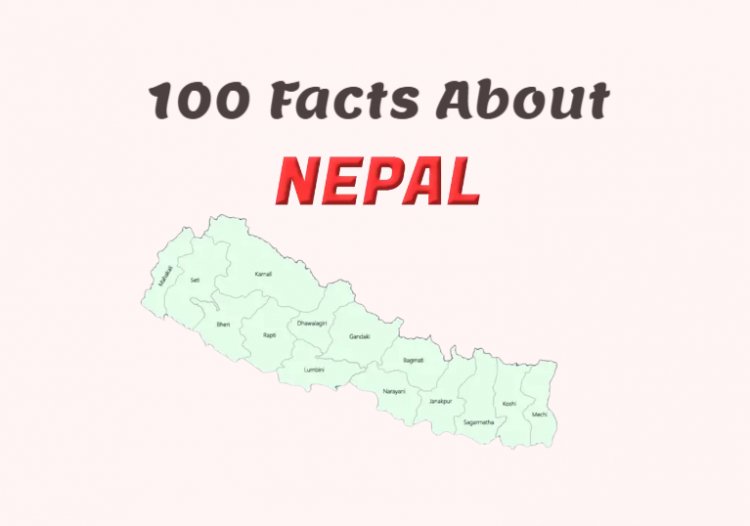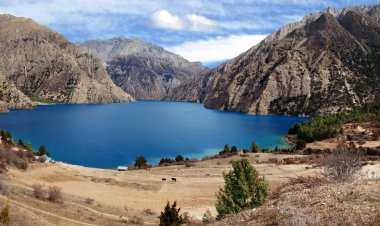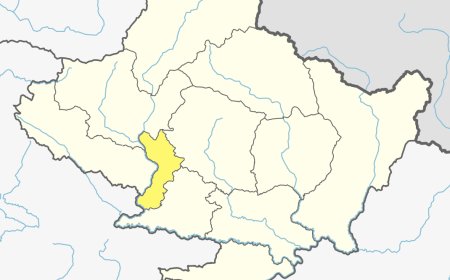100 Interesting Facts About Nepal - Learn About the Culture, History, and Geography of this Fascinating Country
Discover 100 fascinating facts about Nepal, from its rich culture and history to its unique geography and tourism. Learn something new about this beautiful country today.

Nepal is a country located in South Asia, between China and India. It is the world's 93rd largest country by land area, and the 41st most populous country. Nepal is known for its beautiful natural scenery, including the Himalayas, lakes, and forests, and it is home to the highest mountain in the world, Mount Everest.
List of 100 facts about Nepal:
- Nepal is a landlocked country located in South Asia, between India and China.
- It is the 93rd largest country in the world by land area, with a total area of 147,181 square kilometers (56,827 square miles).
- The capital city of Nepal is Kathmandu.
- The official language of Nepal is Nepali.
- The population of Nepal is approximately 29 million people.
- Nepal is a federal democratic republic with a parliamentary system of government.
- The currency of Nepal is the Nepalese Rupee.
- The official religion of Nepal is Hinduism, followed by Buddhism.
- Nepal is home to eight of the world's highest peaks, including Mount Everest, the highest mountain in the world.
- The highest point in Nepal is Mount Everest, which stands at 8,849 meters (29,032 feet) above sea level.
- The lowest point in Nepal is the Kechana Kalan, a depression in the Terai region, which is 70 meters (230 feet) below sea level.
- Nepal is divided into three main geographical regions: the Himalayas, the Hilly Region, and the Terai.
- The Himalayas make up the northern part of the country and are home to the highest peaks in the world.
- The Hilly Region is located in the central part of the country and is characterized by rolling hills and forests.
- The Terai is the southern part of the country and is a lowland region known for its fertile soil and subtropical climate.
- Nepal is home to over 100 different ethnic groups and more than 123 languages are spoken in the country.
- The major ethnic groups in Nepal include the Brahmin, Chhetri, Newar, Magar, Tharu, Tamang, and Gurung.
- Hinduism is the dominant religion in Nepal, followed by Buddhism.
- Nepali is the official language of Nepal, but English is also widely spoken and used in business and education.
- Nepal is a predominantly agricultural country, with around two-thirds of the population working in the sector.
- The main crops grown in Nepal include rice, wheat, maize, potatoes, and sugarcane.
- Nepal is also home to a range of industries, including textiles, carpet-making, and tourism.
- The national animal of Nepal is the cow, which is considered sacred in Hinduism.
- The national flower of Nepal is the Rhododendron, which grows at high altitudes in the Himalayas.
- The national bird of Nepal is the Lophophorus, also known as the Danphe or the Himalayan Monal.
- Nepal is a predominantly Hindu country, with around 80% of the population following the religion.
- Buddhism is also widely practiced in Nepal, and it is the second-largest religion in the country.
- The Newari people are the indigenous inhabitants of the Kathmandu Valley and are known for their rich cultural traditions and artistic skills.
- The Tharu people are an indigenous group that lives in the lowland Terai region of Nepal.
- The Gurung people are an ethnic group from the hill regions of Nepal and are known for their traditional music and dance.
- The Magar people are an ethnic group from the hill regions of Nepal and are known for their traditional music and dance.
- The Tamang people are an ethnic group from the hill regions of Nepal and are known for their traditional music and dance.
- The Chhetri people are an ethnic group from the hill regions of Nepal and are a dominant group in Nepal's political and social spheres.
- The Brahmin people are an ethnic group from the hill regions of Nepal and are a dominant group in Nepal's cultural and religious spheres.
- The Thakali people are an ethnic group from the Mustang region of Nepal and are known for their traditional cuisine and trade.
- The Sherpa people are an ethnic group from the Solu-Khumbu region of Nepal and are known for their skills as mountaineers.
- The Yak is a common animal in Nepal and is used for transportation, milk, and meat.
- The national dish of Nepal is dal bhat, which is a combination of lentils, rice, and vegetables.
- Nepal is home to a wide variety of wildlife, including tigers, rhinos, elephants, and leopards.
- Chitwan National Park is a popular destination for safari tours and is home to a wide variety of wildlife, including rhinos, tigers, and elephants.
- Bardia National Park is also a popular destination for safari tours and is home to a wide variety of wildlife, including tigers, rhinos, and elephants.
- The Annapurna Circuit is a popular trekking route in Nepal and is known for its stunning views of the Himalayas and its diverse landscape.
- The Everest Base Camp trek is also a popular trekking route in Nepal and takes hikers to the base of Mount Everest.
- The Langtang Valley trek is a popular trekking route in Nepal and is known for its beautiful views of the Langtang Lirung glacier.
- The Annapurna Sanctuary trek is another popular trekking route in Nepal and takes hikers to the Annapurna Base Camp.
- The Manaslu Circuit trek is a less-crowded trekking route in Nepal and is known for its stunning views of the Manaslu mountain range.
- The Rara National Park is a beautiful and remote area located in the far western region of Nepal. It is known for its stunning lakes and forests and is a popular destination for trekking and nature walks.
- The Lumbini Garden is a sacred site for Buddhists, as it is believed to be the birthplace of the Buddha. The site is home to a number of temples and monasteries, as well as the Lumbini Museum, which showcases the history of Buddhism in Nepal.
- The Pashupatinath Temple is a sacred site for Hindus, as it is dedicated to the god Shiva. The temple is a popular destination for pilgrims and tourists alike, and it is known for its elaborate architecture and beautiful gardens.
- Swayambhunath is a popular Buddhist temple located in Kathmandu. It is known for its stunning views of the city and its beautiful gardens and is a popular destination for tourists and pilgrims alike.
- Boudhanath is a popular destination for Tibetan Buddhists, as it is home to one of the largest stupas in the world. The stupa is surrounded by a number of monasteries and temples, as well as a bustling market.
- The Kopan Monastery is a Buddhist monastery located just outside of Kathmandu. It is known for its beautiful gardens and peaceful atmosphere and is a popular destination for visitors interested in exploring Buddhism and meditation.
- The Changu Narayan Temple is a Hindu temple located in the Kathmandu Valley. It is one of the oldest temples in Nepal and is known for its beautiful carvings and intricate architecture.
- The Hanuman Dhoka Palace is a historic palace located in Kathmandu. It was the seat of the Nepalese monarchy and is now a museum showcasing the country's royal history.
- The Bhaktapur Durbar Square is a historic square located in Bhaktapur. It is home to a number of temples and palaces and is a popular destination for tourists interested in exploring the city's rich history and culture.
- The Patan Durbar Square is another historic square located in the Kathmandu Valley. It is home to a number of temples and palaces and is a popular destination for tourists interested in exploring the city's rich history and culture.
- The Swayambhunath Stupa is a Buddhist stupa located in Kathmandu. It is one of the oldest and most important stupas in Nepal and is known for its stunning views of the city.
- The Boudhanath Stupa is another Buddhist stupa located in Kathmandu. It is one of the largest stupas in the world and is a popular destination for Tibetan Buddhists.
- The Chitwan National Park is located in the lowland region of Nepal and is home to a wide variety of wildlife, including rhinos, tigers, and elephants.
- The Bardia National Park is also located in the lowland region of Nepal and is home to a wide variety of wildlife, including tigers, rhinos, and elephants.
- The Annapurna region is a popular destination for trekkers and outdoor enthusiasts. It is known for its stunning views of the Himalayas and its diverse landscape, which includes forests, rivers, and high-altitude passes.
- The Pokhara region is another popular destination for trekkers and outdoor enthusiasts. It is known for its stunning views of the Himalayas and its many lakes and waterfalls.
- The Langtang region is a less-crowded trekking destination in Nepal and is known for its beautiful views of the Langtang Lirung glacier.
- The Manaslu region is a less-crowded trekking destination in Nepal and is known for its stunning views of the Manaslu mountain range.
- The Solu-Khumbu region is home to the famous Everest Base Camp trek and is also known for its stunning views of the Himalayas and its rich Sherpa culture.
- The Mustang region is a remote and isolated region in Nepal and is known for its beautiful landscapes and ancient Tibetan Buddhist culture.
- The Rara National Park is located in the far western region of Nepal and is known for its stunning lakes and forests. It is a popular destination for trekking and nature walks.
- The Janakpur region is located in the lowland Terai region of Nepal and is known for its rich cultural heritage and its importance in Hindu mythology. It is home to the Janaki Mandir, a temple dedicated to Sita, the wife of Lord Rama.
- The Thimi region is located just outside of Kathmandu and is known for its traditional pottery and ceramic art.
- The Kavre region is located in the eastern part of Nepal and is known for its beautiful forests and lakes.
- The Dhading region is located in the central part of Nepal and is known for its beautiful views of the Himalayas.
- The Sindhuli region is located in the central part of Nepal and is known for its beautiful views of the Himalayas and its rich cultural heritage.
- The Makwanpur region is located in the central part of Nepal and is known for its beautiful views of the Himalayas and its rich cultural heritage.
- The Sarlahi region is located in the lowland Terai region of Nepal and is known for its rich cultural heritage and its beautiful forests and lakes.
- The Rautahat region is located in the lowland Terai region of Nepal and is known for its rich cultural heritage and its beautiful forests and lakes.
- The Bara region is located in the lowland Terai region of Nepal and is known for its rich cultural heritage and its beautiful forests and lakes.
- The Parsa region is located in the lowland Terai region of Nepal and is known for its rich cultural heritage and its beautiful forests and lakes.
- The Chitwan region is located in the lowland Terai region of Nepal and is known for its beautiful forests and lakes, as well as its rich wildlife and cultural heritage.
- The Nawalparasi region is located in the lowland Terai region of Nepal and is known for its beautiful forests and lakes, as well as its rich wildlife and cultural heritage.
- The Dang region is located in the western part of Nepal and is known for its beautiful forests and lakes, as well as its rich cultural heritage.
- The Pyuthan region is located in the western part of Nepal and is known for its beautiful forests and lakes, as well as its rich cultural heritage.
- The Rolpa region is located in the western part of Nepal and is known for its beautiful forests and lakes, as well as its rich cultural heritage.
- The Salyan region is located in the western part of Nepal and is known for its beautiful forests and lakes, as well as its rich cultural heritage.
- The Rukum region is located in the western part of Nepal and is known for its beautiful forests and lakes, as well as its rich cultural heritage.
- The Jajarkot region is located in the western part of Nepal and is known for its beautiful forests and lakes, as well as its rich cultural heritage.
- The Kalikot region is located in the western part of Nepal and is known for its beautiful forests and lakes, as well as its rich cultural heritage.
- The Mugu region is located in the western part of Nepal and is known for its beautiful forests and lakes, as well as its rich cultural heritage.
- The Dolpa region is located in the western part of Nepal and is known for its beautiful forests and lakes, as well as its rich cultural heritage.
- The Jumla region is located in the western part of Nepal and is known for its beautiful forests and lakes, as well as its rich cultural heritage.
- The Humla region is located in the western part of Nepal and is known for its beautiful forests and lakes, as well as its rich cultural heritage.
- The Bajhang region is located in the western part of Nepal and is known for its beautiful forests and lakes, as well as its rich cultural heritage.
- The Bajura region is located in the western part of Nepal and is known for its beautiful forests and lakes, as well as its rich cultural heritage.
- The Achham region is located in the western part of Nepal and is known for its beautiful forests and lakes, as well as its rich cultural heritage.
- The Doti region is located in the western part of Nepal and is known for its beautiful forests and lakes, as well as its rich cultural heritage.
- The Kailali region is located in the western part of Nepal and is known for its beautiful forests and lakes, as well as its rich cultural heritage.
- The Kanchanpur region is located in the western part of Nepal and is known for its beautiful forests and lakes, as well as its rich cultural heritage.
- The Bardiya region is located in the western part of Nepal and is known for its beautiful forests and lakes, as well as its rich cultural heritage.
- The Kaski region is located in the western part of Nepal and is known for its beautiful forests and lakes, as well as its rich cultural heritage.
- The Lamjung region is located in the western part of Nepal and is known for its beautiful forests and lakes, as well as its rich cultural heritage.
- The Tanahu region is located in the western part of Nepal and is known for its beautiful forests and lakes, as well as its rich cultural heritage.
What's Your Reaction?





































































































